Aichi Complex | Environmental Initiatives
At our company, we aim to create all Refineries/Complexes Refineries/Complexes "beautiful, pollution-free,'' Refineries/Complexes beloved by local people.'' Based on this basic stance, our Complex has been set up as a green "park factory" with a green belt planted with 450,000 trees since the time of operation. In the green belt, you can see many small animals and birds, and it also acts as a buffer zone to prevent noise. We will continue to place great importance on harmony with the natural environment.
Environmental policy
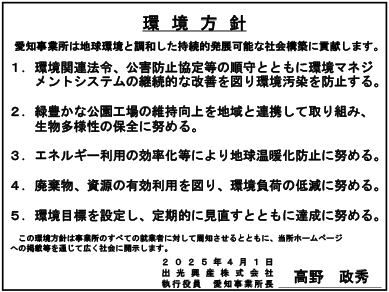
Environmental Partnership/CLUB

"Environmental Partnership CLUB" is an organization centered on governments and businesses in Aichi, Gifu, and Mie prefectures that tackles environmental issues with the aim of building a recycling-oriented economic and social system, and has approximately 300 member companies. Masu.
Our office has been participating in the "Environmental Partnership CLUB" since its establishment.
Reduction of final disposal amount of industrial waste
As a result of our efforts to achieve the goal of "achieving zero emissions* in fiscal 2008,'' which is part of our Complex-wide medium-term environmental plan, we achieved this goal in 2004, three years ahead of schedule.
To achieve zero emissions, we have been promoting measures such as reducing the amount of waste through dehydration, reusing used catalysts, and Resources waste. Aiming to further reduce waste, we will promote activities from the viewpoints of the 3Rs: Reduce, Reuse, and Resources.
-
Definition of zero emissions: The amount of final (landfill) disposal of waste generated is 1% or less
Promotion of energy conservation
Aichi Complex began Complex as the newest Refinery in Japan, having been completed in 1975 after the first oil shock, and has been extremely energy efficient since its construction. In addition, all staff members have worked together to repeatedly improve energy efficiency.
Our goal is to reduce CO2 emissions from our own operations by 7.3 million tons by 2030, and we have begun considering energy-saving improvements and fuel conversion.
Environmental measures
Air pollution prevention measures

Flue gas desulfurization equipment that reduces SO x
As air pollutants, Complex generates sulfur oxides (SOx), nitrogen oxides (NOx), and soot from boilers, heating furnaces, etc. The generated SOx is reduced by removing it with flue gas desulfurization equipment. In addition, hydrogen sulfide generated from refining equipment such as heavy oil desulfurization equipment is processed in sulfur recovery processing equipment and recovered as sulfur.
Next, we are reducing NOx emissions by using low NOx burners, adopting two-stage combustion, and installing flue gas denitrification equipment. We also reduce soot and dust by removing it from the exhaust gas using electrostatic precipitators.
Through these reduction measures, we are complying with internal standards that are stricter than the Air Pollution Control Act and the pollution control agreements concluded with Aichi Prefecture and Chita City.
Water pollution prevention measures
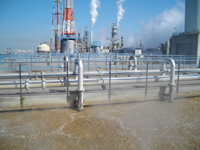
Activated sludge treatment equipment
The water discharged from the facilities at our Complex is treated using methods such as coagulation sedimentation, activated sludge treatment, and activated carbon treatment. In addition, the treated wastewater complies with our in-house standards, which are stricter than the Water Pollution Control Act and the pollution prevention agreements concluded with Aichi Prefecture and Chita City, for hydrogen ion concentration (pH), nitrogen content, phosphorus content, and chemical oxygen demand (COD), etc. Annual emissions can be confirmed in the environmental data below.
Furthermore, in fiscal 2011, we expanded our facilities to remove COD and phosphorus from wastewater, further reducing pollution.
Soil pollution prevention measures
The Soil Contamination Countermeasures Act went into effect in February 2003, making it mandatory to conduct a soil contamination investigation when a designated facility that uses hazardous substances is closed down or when the governor recognizes that there is a risk of health damage.
Although there was no obligation to investigate at our Complex, we conducted voluntary investigations of the premises from 2003 to 2008 based on the company-wide medium-term environmental plan and confirmed that there were no problems related to soil contamination. Additionally, since 2003, we have been measuring groundwater at the site boundary once a year, and we continue to confirm that there are no problems with groundwater.
Initiatives to control chemical substance emissions
Chemical substances discharged from our Complex that are subject to the PRTR Law (Law for Promoting Identification of Release Amounts of Specific Chemical Substances into the Environment and Improvement of Their Management) include benzene, toluene, and xylene, which are contained in crude oil and petroleum products, as well as asbestos, which was used as a pipe insulation material.
For targeted substances derived from crude oil and petroleum products (benzene, toluene, xylene), we are working to reduce emissions by using floating roof tanks, which reduce the amount of vapor emitted into the atmosphere from the tanks, and by installing volatile hydrocarbon recovery equipment at shipping facilities.
Gas recovery at lorry station
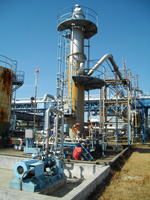
Gas recovery equipment at lorry station
Since the beginning of operations, our Complex has installed volatile organic compounds (VOC) recovery device at the truck station to recover the hydrocarbon gases that are generated when tank trucks are loaded. The recovery method is to absorb the hydrocarbon gases by bringing them into contact with kerosene, which is the recovered oil, in the device, thereby reducing emissions into the atmosphere.
environmental data
Corporate forest
In 2010, our Complex was certified as a "Socially and Environmentally Contributing Green Space" by the Social and Environmentally Contributing Green Space Evaluation System (SEGES) operated by the Urban Green Infrastructure Fund (now the Public Interest Incorporated Foundation, Urban Green Infrastructure Organization).
This recognition recognizes our efforts in creating a "Park Factory," which has been our goal since the construction of Refinery, and in the creation of the "Idemitsu 100 Year Forest" project as part of Idemitsu's 100th anniversary of operations. Aichi Complex received the "Excellent Stage 3" certification.
In addition, based on the Green Garden City Concept of the Chita Citizens' Pledge, "the green belt is an important environmental Resources for the region," Chita City's coastal businesses are working together to maintain and improve the green belt with the aim of contributing to improving biodiversity and linking ecosystems. This certification recognizes the fact that our Complex is positioned at the center of these activities.
In 2016, their activities were recognized and they were certified as "Superlative Stage", the highest level in SEGES.
Our Complex will continue to carry out green space activities that contribute to the local environment.
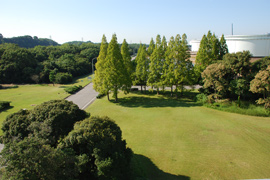
Complex are filled with greenery
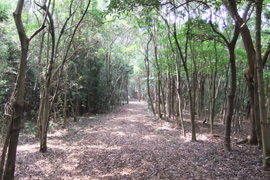
Take a walk on the promenade
Commuting road cleaning
Aichi Complex is a member of the Chita Sanshi Association, which organizes a cleanup event for the Meiko Service Road twice a year. Volunteers are recruited from among the plant's employees to collect trash that has been dumped on the median strip and along the side of the road gutters.

Carefully pick up trash inside the median fence
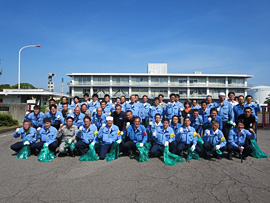
Now let's start picking up trash!